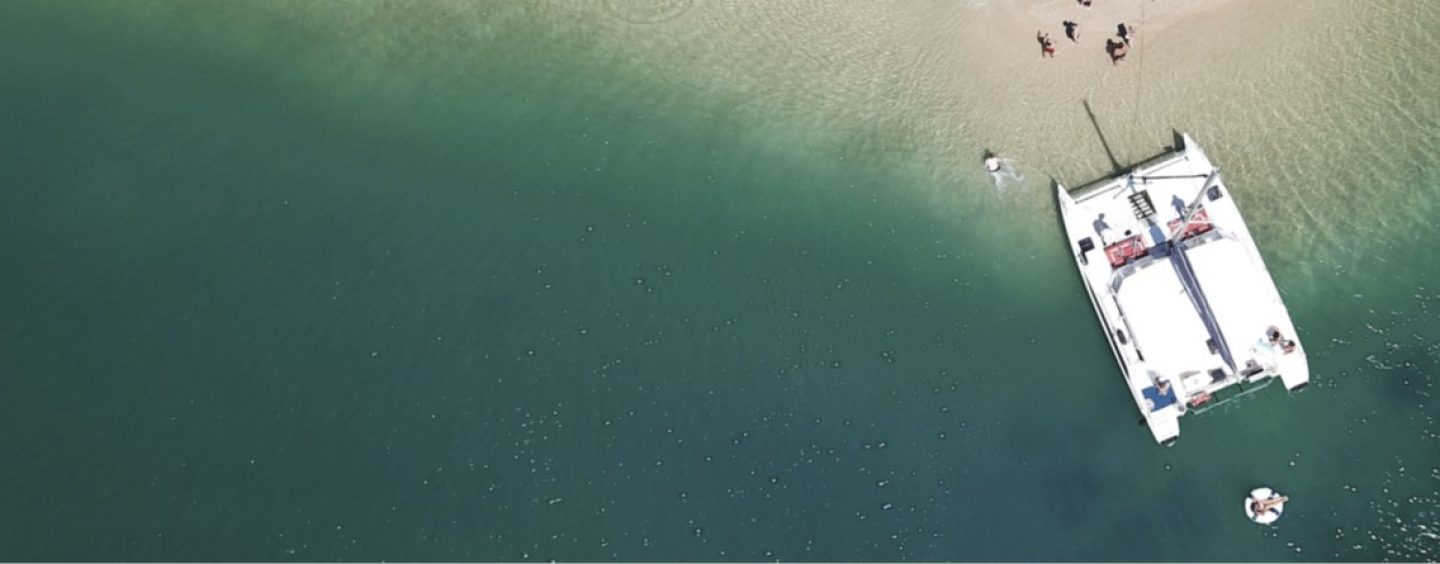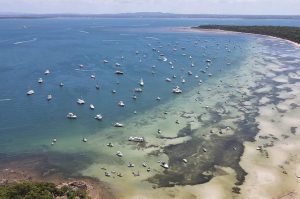by Roselle Tenefrancia
SO, HOW DO WE VALUE OUR WATERWAYS?
This is the bottomline question of two research studies that focus on the social values of the Gold Coast waterways and Moreton Bay. The reports reflect the values that recreational boaters place on our significant waterways.
SOCIO-ECONOMIC USES AND ECONOMIC VALUE STUDY OF THE GOLD COAST WATERWAYS (2017)
In 2017, the Gold Coast Waterways Authority released a report on a study of the socio-economic uses and economic value of the Gold Coast waterways. The survey was conducted in March and April 2017. There were 290 respondents who, according to the study, represented the general demographic make-up of the Gold Coast in terms of household type, distance from the waterways, etc. Note that the survey was conducted among a broad range of people, which include recreational boaters.
One of the key findings in the study involves the estimated value of ecosystem services that can be attributed to the waterways. The estimate of $670 million per year is dominated by recreational uses of waterways by locals (as opposed to tourism use). These uses are not normally counted within any typical economic measure of the regional economy.
Waterways provide significant social, cultural, economic and environmental benefits and services for Gold Coast communities. Recreational uses like sailing, boating, fishing, swimming, canoeing and water-skiing occur across the waterways and, together with established tourism and water-based commercial enterprises, make a significant contribution to the local economy.
The consequences of such uses require extensive infrastructure to support these uses. Indeed, there has been considerable, previous ‘redesign’ of waterways (such as the Gold Coast Seaway) to provide safe navigational access, flood mitigation and social and economic uses (such as canal estates, navigation channels and reclamation for development).
One aspect of the survey involves social values placed on the waterways. Social values were identified and explored by means of a literature review, statistical analysis of previous survey and demographic data, and through consultation with key informants and stakeholders.
Based on the survey, second on the list of activities conducted on the Gold Coast waterways was boating and sailing (with 62.5% respondents). Recreational fishing came fourth on the list (with 52.6%), followed by swimming (with 50.9%). It is worthwhile to note that the most popular activity is walking, cycling or running next to waterways (with 72.5%).
In the last six years, including the pandemic lockdown period, we would have seen a significant increase in the uses of the waterways, particularly for boating. We have already seen that recreational boating has been a popular choice of activity during the times when social distancing and limited outdoor recreation activities were enforced in the country. In 2021, the Boating Industry Association saw an increase to 18,500 new recreational vessel registrations since 2020 nationwide. With this in mind, our local waterways would have seen a similar rate of increase in boating activities, also reflected in the orders for new boats from local boat manufacturers, as well as in the number of services required from marine service providers.
In terms of appreciation for the waterways uses on the Gold Coast, 93.1% of the respondents to the survey indicated that a significant reason for them choosing to live on the Gold Coast is our waterways. In addition, 96% of the respondents agreed that the waterways contribute to their personal health and wellbeing, and that if the waterways access, safety and conditions declined significantly, a good majority of them (85.6%) would reduce their visit to or use of the waterways, while 56% would consider moving from the Gold Coast to another location.
Property values are also significantly affected by the quality of the waterways. The study found that waterways add to property values on the Gold Coast, and any major declines in waterways would severely impact property values. This conclusion is based on numerous studies and industry experience showing that proximity to, direct access to or views of water enhance property value, and high levels of proximity to waterways due to the Gold Coast’s historical development patterns and the expansive canals and river network.
The top four threats to the Gold Coast waterways have been identified by respondents as the following: population growth and increase in pollution (71.8%), overuse and congestion on and next to the waterways (54%), development projects that block access to waterways (53%), infrastructure not coping with demand (37.6%). While these four are concerned with geo-political and infrastructure challenges, the fifth most identified threat (by 21.6% of respondents) is climate change and sea level rise. This shows that people are aware that environmental changes will significantly affect the quality of our waterways and eventually have an impact on their social values.
To maintain the significant social and personal values that many people have of our local waterways, it is important for government agencies and community to ensure that more work is done to enhance access to waterways and reduce congestion in high-use areas, to protect and enhance the natural aspects of the waterways, to invest more resources for waterway management.
From this study, the bottom line is that waterways are a very important economic and social asset that assists in underpinning the Gold Coast’s phenomenal success as a world class destination for tourism and regional growth more broadly. There is a strong economic and social case for enhanced management. This is also supported strongly by the community and waterway-reliant businesses alike.
MAPPING SOCIAL VALUES OF MORETON BAY
In 2022, an interdisciplinary study by University of Queensland researchers was conducted to map out social values of Moreton Bay. This survey focused on the places that recreational boaters visit and why these places are special to them. The research team used a combination of in-person and online survey questions with a Geographic Information System (GIS) platform to record and map boaters’ responses.
Their findings show that people cherish many different areas within the Moreton Bay Marine Park for a wide range of reasons, some of which are more important than others. This information can inform decision-making and communication strategies that promote care and stewardship for the natural – and social – environments people experience in the Bay.
“Recreational boaters clearly love the Bay. The natural environment features as a strong reason why boaters enjoy visiting the area. The natural beauty of the Bay is highly valued, as are experiences of nature (such as seeing wildlife and exploring the natural world). This suggests that most recreational boaters would like to see the natural environment looked after so they can continue to enjoy the Bay into the future.”
“Interestingly, human-centred reasons also featured highly on the list of values for recreational boaters. Specifically, boaters appreciate “getting away from it all” (therapeutic reasons) and spending time with friends and family on the Bay.”
The research obtained 304 valid responses. Based on the places identified, it also appears that the respondents are mostly based around the Brisbane and Moreton Bay area. Given the sparse information on Gold Coast locations, there seems to be very few Gold Coast boaters who were aware of the survey.
Nevertheless, it is worth looking at the results as these also somehow reflect similar values that many Gold Coast boaters have.
From the 304 respondents who volunteered to participate in the survey, there were 74.3% who own boats. About 37% indicated they use open runabout boats, about 27% use cabin cruisers, around 25% use sailing boats, and almost 8% use PWCs.
Based on the results of the research study, the majority of the respondents visit Peel Island and Moreton Island, specifically the Tangalooma area. It is worth noting that the waters surrounding Peel Island are zoned as marine national park and conservation park. From the maps on the website, it can be surmised that many boaters visit the waters around the area mostly for the natural beauty and the environmental value of the locations.
The study developed a list of social values relevant to the use of the bay areas by boaters. The values can be categorised as: environment-centred, human-centred, spiritual and culture-centred values. The first category includes appreciation for and experiencing nature. Human-centred values include for practical reasons (such as fishing, easy access), for safety and security, for conquering challenges, and for studying. Spiritual and culture-centred values include a sense of obligation to care for the place, valuing the place as sacred, and being a place for conducting cultural practices.
The top two values that many respondents related to are environment-centred: appreciation of natural beauty (97.7%), and experiencing nature (90.8%). These two values are related to the natural character of Moreton Bay that indicate that boaters primarily value the experiences that are influenced by their appreciation for nature. Interestingly, the lowest three were relevant to cultural (13.5%), spiritual (21.4%) and challenges (25%). In between these two sets are the mix of human-centred values involving therapeutic reasons, sharing experiences with others, sense of safety and security, and spiritual values involving love for the place and being a source of inspiration.
It is clear that the diversity of values placed on Moreton Bay signifies that people experience recreational boating in very different ways. While the study reports that many of the boaters visit Peel Island and Tangalooma for their natural significance, the boating activity also involves human-centred and cultural significance; hence, the value of the places within Moreton Bay are all-encompassing.
As the researchers suggest, when it comes to managing these natural areas, decision-makers will need to keep in mind that people are choosing to visit these areas for a variety of reasons, some of which may support conservation and management goals and some of which may be in conflict with these goals.
VALUE YOUR WATERWAYS
The two research reports provide us a glimpse of what government agencies consider in their policy-making and decision-making activities that affect our experiences on the waterways. The values that have been included in the reports were obtained from what people (mostly local residents) believe are most important for them.
Our waterways are a life-source. They feed into the ocean and serve as our connection to the world. We tend to take for granted that we are living in a waterways city, and that their values go beyond their use as a navigational path.
Most of us can most likely relate to the experiences shared by the respondents in the both research surveys on the Gold Coast and Moreton Bay. As we find personal enjoyment in boating, let us also remind ourselves to consistently appreciate the waterways. What makes us keep going back to places like Jumpinpin or Wave Break Island? What makes us create unique experiences on South Stradbroke Island?
How we value our waterways will reflect on our use of them, and on how much responsibility we will take on to take care of our waterways.
Published in print July-September 2023
































